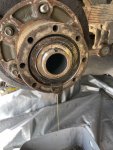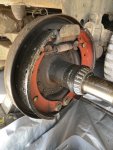When I bought this deuce there was a very small leak around the inside of the tire. I thought it might be a wheel cylinder but the smell was a dead giveaway that it was gear oil. The last couple of times I took it for a short drive, it went from a small leak to leaving a puddle under the tire. I already have the parts from big mikes so I've decided this is next on the maintenance agenda. On disassembly everything outside and inside are coated with gear oil so I'm sure that brake wasn't doing much, lol. That might explain why the temp was so low compared to the others -- no friction! Also the little cork stopper was squished flat. There was so much oil in there that most of the grease was washed out but the bearings still look pristine given they were in a gear oil bath. Also the inner hub nut was essentially hand tight. I just took in off with my fingers -- no torque needed.
I have the inner hub seals as part of the kit I got. Should I go ahead and replace them or leave them be? I know they are essentially there to keep grease in and dirt out. If they aren't visibly damaged it just seems like removing them and putting new ones in introduces additional possibility of error and of course introduces chinese parts. I'm going to use the gray RTV or possibly "The Right Stuff" that I've seen posted elsewhere in the keyway instead of cork. I'll post up when I'm done and the results.
I also had one wheel lug nut bite so hard on the inner lug that it backed out the inner lug before coming off. To separate them, I soaked with PB blaster and held the lug nut with a large crescent and used a 12 point 15/16 socket over the square-tipped stud to work it in/out until enough lube was on the threads to loosen things up and I finally worked them apart. Nothing is ever simple, lol.
And yes, I'll check the wheel cylinder while I'm there.
I have the inner hub seals as part of the kit I got. Should I go ahead and replace them or leave them be? I know they are essentially there to keep grease in and dirt out. If they aren't visibly damaged it just seems like removing them and putting new ones in introduces additional possibility of error and of course introduces chinese parts. I'm going to use the gray RTV or possibly "The Right Stuff" that I've seen posted elsewhere in the keyway instead of cork. I'll post up when I'm done and the results.
I also had one wheel lug nut bite so hard on the inner lug that it backed out the inner lug before coming off. To separate them, I soaked with PB blaster and held the lug nut with a large crescent and used a 12 point 15/16 socket over the square-tipped stud to work it in/out until enough lube was on the threads to loosen things up and I finally worked them apart. Nothing is ever simple, lol.
And yes, I'll check the wheel cylinder while I'm there.
Attachments
-
90.7 KB Views: 27
-
92.7 KB Views: 30
-
33.7 KB Views: 27








